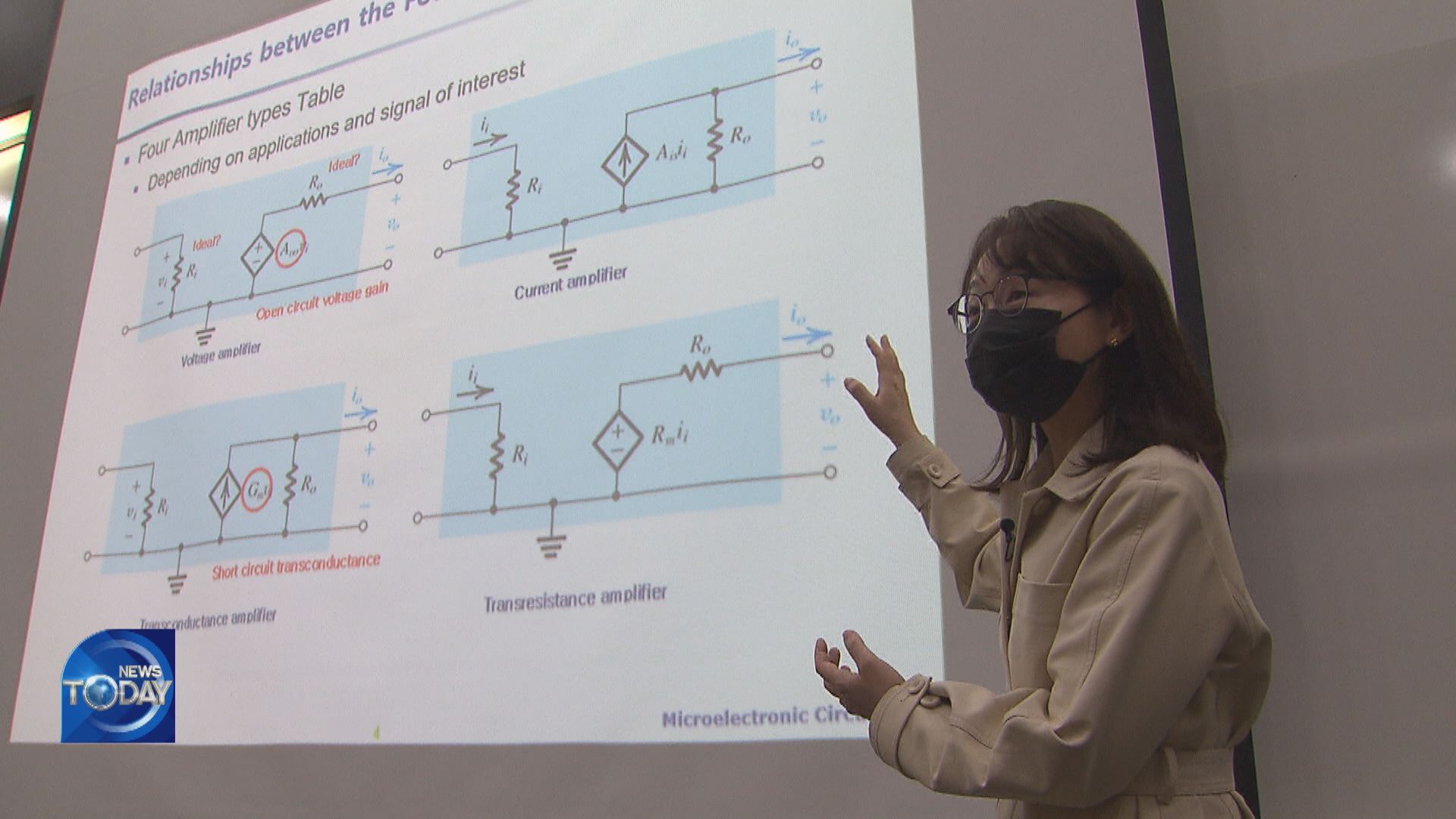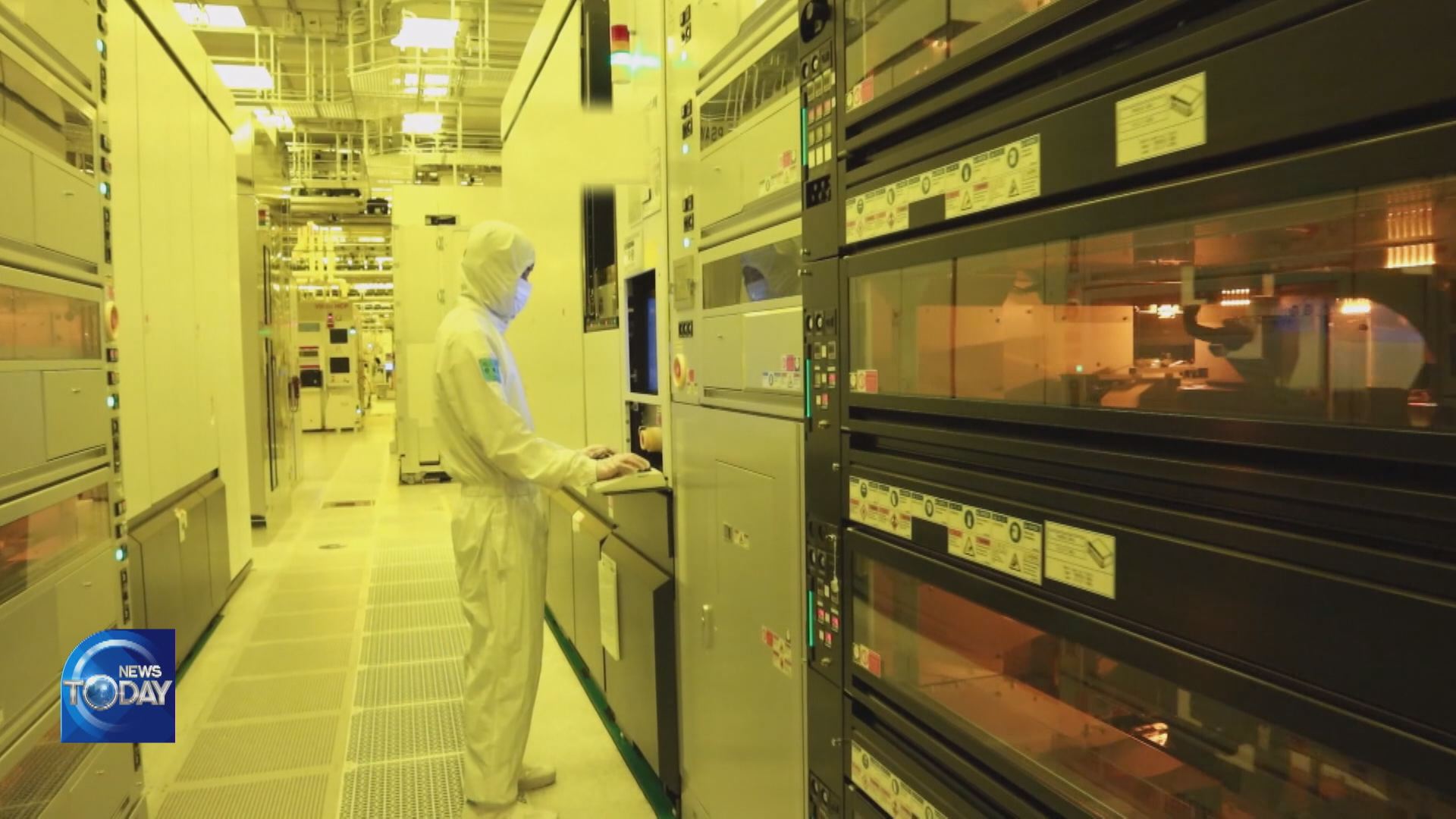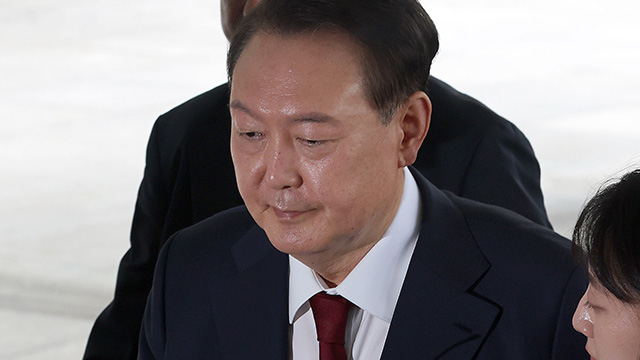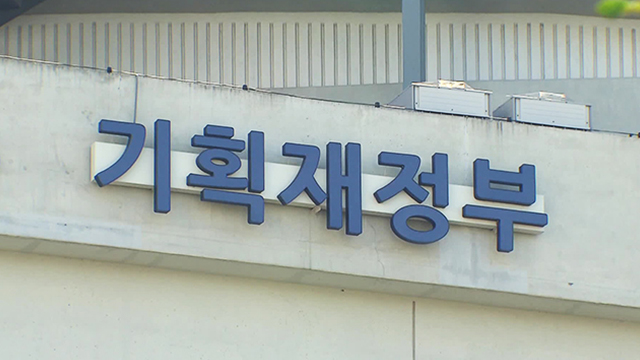SEMICONDUCTOR INDUSTRY CRISIS
입력 2022.04.08 (15:12)
수정 2022.04.08 (16:46)
읽어주기 기능은 크롬기반의
브라우저에서만 사용하실 수 있습니다.
[Anchor Lead]
The semiconductor industry, which accounts for 20% of Korean export, appears to be in crisis. Several factors are cited to have brought about the difficulty, but the most serious issue is a shortage of skilled workers.
[Pkg]
In this college classroom, a lecture about semiconductor circuit designs is underway.
[Soundbite] “IC design is extremely popular. Almost all digital designs use coding.”
This course was set up jointly by a local conglomerate and a university. Students who take this class are guaranteed employment after graduation.
[Soundbite] Yun Hye-jun(Sophomore, Sungkyunkwan Univ.) : “I can become an engineer if my GPA is higher than 3.0 and I pass the minimal hiring process. Scholarship is available for four semesters and additional scholarship is paid once a student passes the entrance test.”
Currently, three universities have such semiconductor-related departments that ensure employment through a corporate-university partnership. There are about 170 students, mostly in bachelors’ programs. But given the nature of the industry, what they need on the site right now are people with master’s and doctorate degrees. More than 1,000 people are needed every year, but local graduates can only meet 10% of the demanded manpower. Since most students prefer giant corporations, SMEs suffering from manpower shortages are forced to recruit workers from Southeast Asia and other foreign regions.
[Soundbite] Lee Seo-gyu(Korea Fabless Federation) : “There are just too few workers, not enough to meet the demands of even the conglomerates. So it’s nonsense to say they’re willing to nurture small venture businesses or the Fabless industry.”
The Special Act on Semiconductors designed to promote the sector is scheduled to go into effect later this year, but the industry’s demand to increase the size of semiconductor-related departments in the universities in the capital region hasn’t been accepted because other local universities may be neglected. The department quotas have been increased through the government’s enforcement ordinances but this measure is not an immediate solution since it is limited to bachelor’s programs. The global semiconductor market is fiercely competitive, so much so that it is often called a silent war. If that's the case, Korea has no troops to send to the battlefield.
The semiconductor industry, which accounts for 20% of Korean export, appears to be in crisis. Several factors are cited to have brought about the difficulty, but the most serious issue is a shortage of skilled workers.
[Pkg]
In this college classroom, a lecture about semiconductor circuit designs is underway.
[Soundbite] “IC design is extremely popular. Almost all digital designs use coding.”
This course was set up jointly by a local conglomerate and a university. Students who take this class are guaranteed employment after graduation.
[Soundbite] Yun Hye-jun(Sophomore, Sungkyunkwan Univ.) : “I can become an engineer if my GPA is higher than 3.0 and I pass the minimal hiring process. Scholarship is available for four semesters and additional scholarship is paid once a student passes the entrance test.”
Currently, three universities have such semiconductor-related departments that ensure employment through a corporate-university partnership. There are about 170 students, mostly in bachelors’ programs. But given the nature of the industry, what they need on the site right now are people with master’s and doctorate degrees. More than 1,000 people are needed every year, but local graduates can only meet 10% of the demanded manpower. Since most students prefer giant corporations, SMEs suffering from manpower shortages are forced to recruit workers from Southeast Asia and other foreign regions.
[Soundbite] Lee Seo-gyu(Korea Fabless Federation) : “There are just too few workers, not enough to meet the demands of even the conglomerates. So it’s nonsense to say they’re willing to nurture small venture businesses or the Fabless industry.”
The Special Act on Semiconductors designed to promote the sector is scheduled to go into effect later this year, but the industry’s demand to increase the size of semiconductor-related departments in the universities in the capital region hasn’t been accepted because other local universities may be neglected. The department quotas have been increased through the government’s enforcement ordinances but this measure is not an immediate solution since it is limited to bachelor’s programs. The global semiconductor market is fiercely competitive, so much so that it is often called a silent war. If that's the case, Korea has no troops to send to the battlefield.
■ 제보하기
▷ 카카오톡 : 'KBS제보' 검색, 채널 추가
▷ 전화 : 02-781-1234, 4444
▷ 이메일 : kbs1234@kbs.co.kr
▷ 유튜브, 네이버, 카카오에서도 KBS뉴스를 구독해주세요!
- SEMICONDUCTOR INDUSTRY CRISIS
-
- 입력 2022-04-08 15:12:27
- 수정2022-04-08 16:46:23

[Anchor Lead]
The semiconductor industry, which accounts for 20% of Korean export, appears to be in crisis. Several factors are cited to have brought about the difficulty, but the most serious issue is a shortage of skilled workers.
[Pkg]
In this college classroom, a lecture about semiconductor circuit designs is underway.
[Soundbite] “IC design is extremely popular. Almost all digital designs use coding.”
This course was set up jointly by a local conglomerate and a university. Students who take this class are guaranteed employment after graduation.
[Soundbite] Yun Hye-jun(Sophomore, Sungkyunkwan Univ.) : “I can become an engineer if my GPA is higher than 3.0 and I pass the minimal hiring process. Scholarship is available for four semesters and additional scholarship is paid once a student passes the entrance test.”
Currently, three universities have such semiconductor-related departments that ensure employment through a corporate-university partnership. There are about 170 students, mostly in bachelors’ programs. But given the nature of the industry, what they need on the site right now are people with master’s and doctorate degrees. More than 1,000 people are needed every year, but local graduates can only meet 10% of the demanded manpower. Since most students prefer giant corporations, SMEs suffering from manpower shortages are forced to recruit workers from Southeast Asia and other foreign regions.
[Soundbite] Lee Seo-gyu(Korea Fabless Federation) : “There are just too few workers, not enough to meet the demands of even the conglomerates. So it’s nonsense to say they’re willing to nurture small venture businesses or the Fabless industry.”
The Special Act on Semiconductors designed to promote the sector is scheduled to go into effect later this year, but the industry’s demand to increase the size of semiconductor-related departments in the universities in the capital region hasn’t been accepted because other local universities may be neglected. The department quotas have been increased through the government’s enforcement ordinances but this measure is not an immediate solution since it is limited to bachelor’s programs. The global semiconductor market is fiercely competitive, so much so that it is often called a silent war. If that's the case, Korea has no troops to send to the battlefield.
The semiconductor industry, which accounts for 20% of Korean export, appears to be in crisis. Several factors are cited to have brought about the difficulty, but the most serious issue is a shortage of skilled workers.
[Pkg]
In this college classroom, a lecture about semiconductor circuit designs is underway.
[Soundbite] “IC design is extremely popular. Almost all digital designs use coding.”
This course was set up jointly by a local conglomerate and a university. Students who take this class are guaranteed employment after graduation.
[Soundbite] Yun Hye-jun(Sophomore, Sungkyunkwan Univ.) : “I can become an engineer if my GPA is higher than 3.0 and I pass the minimal hiring process. Scholarship is available for four semesters and additional scholarship is paid once a student passes the entrance test.”
Currently, three universities have such semiconductor-related departments that ensure employment through a corporate-university partnership. There are about 170 students, mostly in bachelors’ programs. But given the nature of the industry, what they need on the site right now are people with master’s and doctorate degrees. More than 1,000 people are needed every year, but local graduates can only meet 10% of the demanded manpower. Since most students prefer giant corporations, SMEs suffering from manpower shortages are forced to recruit workers from Southeast Asia and other foreign regions.
[Soundbite] Lee Seo-gyu(Korea Fabless Federation) : “There are just too few workers, not enough to meet the demands of even the conglomerates. So it’s nonsense to say they’re willing to nurture small venture businesses or the Fabless industry.”
The Special Act on Semiconductors designed to promote the sector is scheduled to go into effect later this year, but the industry’s demand to increase the size of semiconductor-related departments in the universities in the capital region hasn’t been accepted because other local universities may be neglected. The department quotas have been increased through the government’s enforcement ordinances but this measure is not an immediate solution since it is limited to bachelor’s programs. The global semiconductor market is fiercely competitive, so much so that it is often called a silent war. If that's the case, Korea has no troops to send to the battlefield.
이 기사가 좋으셨다면
-
좋아요
0
-
응원해요
0
-
후속 원해요
0













![[속보] 정성호 법무장관 후보자 “검찰 해체 표현 적절치 않아…국민 눈높이 맞는 개혁 이뤄야”](/data/layer/904/2025/07/20250701_86evyp.png)



이 기사에 대한 의견을 남겨주세요.